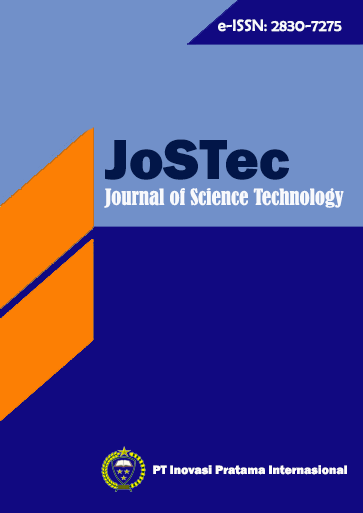THE EFFECT OF IMPLEMENTING BUILDING STRUCTURE AND CONSTRUCTION SYSTEMS ON ENERGY EFFICIENCY
DOI:
https://doi.org/10.55299/jostec.v6i1.871Abstract
This research aims to investigate the effect of implementing structural systems and building construction on energy efficiency. Quantitative analysis methods are used with the help of SPSS Version 27 to test the correlation between structural system variables, building construction and energy efficiency. A linear regression test was carried out to understand how much influence the application of structural systems and building construction has on energy efficiency. The results of the research show that the application of the structure and building construction system has an effect on energy efficiency, where each increase of one unit influences the application of the structure and building construction system to 100% energy efficiency. In addition, the Pearson correlation test shows that there is a strong relationship between the application of structural systems and building construction and energy efficiency. A high correlation coefficient indicates that implementing the right system has the potential to increase building energy efficiency. These findings show the importance of selecting appropriate structural systems and building construction in achieving high energy efficiency. Thus, this research contributes to understanding how to build more energy efficient buildings.
Downloads
References
Abdullah, S., Mendila, H., Febriansyah, MC, & Ibrahim, A. (2020). Application of "Glulam" Laminated Wood as the Main Material in the Children's Center Building Structure. TIMPALAJA : Architecture Student Journals , 2 (1), Article 1. https://doi.org/10.24252/timpalaja.v2i1a7
Arianto, DAU, & Setyaningsih, W. (2024). IMPLEMENTATION OF GREEN BUILDING AT A 5 STAR CITY HOTEL IN JAKARTA USING EDGE APP AND GREENSHIP. Senthong , 7 (2), Article 2. https://jurnal.ft.uns.ac.id/index.php/senthong/article/view/1879
Azhari, S., Nurdin, AL, Feriska, Y., Apriliano, DD, & Imron, I. (2021). Implementation Study of the Use of Kalsifloor as a Replacement for Cast Concrete in the RSIA Permata Insani Building, Brebes Regency. Infratech Building Journal , 2 (1), Article 1. https://doi.org/10.46772/ibj.v2i1.1356
Boer, A., Gobang, AAKS, & Parera, Y.T. (2023). APPLICATION OF SUSTAINABLE ARCHITECTURAL PRINCIPLES IN THE LEPA RIA KUNU MBENGU PAGA TRADITIONAL HOUSE, SIKKA DISTRICT. Increate - Innovation And Creation In Information Technology , 9 (1). https://increate.nusanipa.ac.id/index.php/increate/article/view/52
Darmawan, A. (2023). Mechanical Engineering Innovation to Increase Energy Efficiency. Engineering Student Practical Work Report , 1 (6). https://coursework.uma.ac.id/index.php/teknik/article/view/305
Diarja, RDW, & Anwar, U. (2024). IMPLEMENTATION OF OCCUPATIONAL SAFETY AND HEALTH (K3) AS A FULFILLMENT OF PRISONER'S HUMAN RIGHTS. TOPLAMA , 1 (2), 73–81. https://doi.org/10.61397/tla.v1i2.64
Fikkri, K. (2023). INVESTIGATION OF INCREASING THE EFFICIENCY OF USING STEEL IN REINFORCED CONCRETE BUILDINGS. ENGINEERING SCIENCE RESEARCH JOURNAL , 2 (1), 10–22. https://doi.org/10.55606/jurritek.v2i1.865
Gunawan, R. (2024). SUSTAINABLE CONSTRUCTION MATERIALS: A COMPREHENSIVE REVIEW OF ENGINEERING AND APPLICATIONS. Journal of Education and Teaching Review (JRPP) , 7 (1), 849–854. https://doi.org/10.31004/jrpp.v7i1.24762
Hendrik, ML, & Tualaka, TMC (2023). Application of Double Skin Façade as a Building Energy Efficiency Strategy in Tropical Climate Areas. GEWANG: Gateway to Discourse and Architectural Design , 5 (1), Article 1.
Jannah, L.M. (2019). Quantitative research methods . Rajawali Press.
Kurniawan, B., Mochtar, K., & Simanjuntak, MRA (2020). Analysis of Construction Components in the Implementation of Green Building Requirements according to the Indonesian Green Building Council (GBCI) . http://publikasiilmiah.ums.ac.id/handle/11617/12162
Maharani, MR, & Prianto, E. (2021). APPLICATION OF BIOCLIMATIC PRINCIPLES IN RESIDENTIAL BUILDINGS. Journal of Collaborative Architecture , 1 (2), Article 2. https://doi.org/10.54325/kolaborasi.v1i2.10
Marpaung, PHF (2024). OPTIMIZATION OF STRUCTURAL DESIGN FOR ENERGY EFFICIENCY IN BUILDINGS. Civil Student Assignments , 1 (1). https://coursework.uma.ac.id/index.php/sipil/article/view/505
Mediastika, C.E. (2021). Saving Energy and Sustaining the Environment Through Buildings . Andi Publisher.
Nasution, AF (2020). V The Role of Correctional Centers in Fulfilling Children's Rights Against the Law at BAPAS Class 1 South Jakarta [Bachelor Thesis, Faculty of Da'wah and Communication Sciences, Syarif Hidayatullah State Islamic University, Jakarta]. https://repository.uinjkt.ac.id/dspace/handle/123456789/51478
Niasih, PAD (2021). Energy Efficient Resort in Sanur, Bali. eDimensions of Petra Architecture , 9 (1), Article 1.
Ningrum, DR, & Yuliani, S. (2024). BUILDING ENERGY EFFICIENCY STRATEGIES ON THE CAMPUS OF THE FACULTY OF INFRASTRUCTURE ENGINEERING BACHARUDDIN JUSUF HABIBIE INSTITUTE OF TECHNOLOGY TOWARDS A SUSTAINABLE CAMPUS. Senthong , 7 (2), Article 2. https://jurnal.ft.uns.ac.id/index.php/senthong/article/view/1871
Prawiyogi, AG, & Anwar, AS (2023). Development of the Internet of Things (IoT) in the Energy Sector: Systematic Literature Review. MENTARI Journal: Management, Education and Information Technology , 1 (2). https://doi.org/10.33050/mentari.v1i2.254
Ryan, P. (2019). The Paradox of Hegemony and the “Multiculturalism of the Individual.” Canadian Ethnic Studies , 51 (2), 153–167.
Sahar, K., & Aqli, W. (2020). STUDY OF FUTURISTIC ARCHITECTURE IN EDUCATIONAL BUILDINGS. Nature: National Academic Journal of Architecture , 7 (2), Article 2. https://doi.org/10.24252/nature.v7i2a10
Witama, H.N., & Saliya, Y. (2024). CRITICAL STUDY OF THE IMPACT OF POST-MODERN ARCHITECTURE ON THE REALIZATION OF THE ENERGY JAKARTA OFFICE BUILDING TYPOLOGY. Architectural Research (RISA) , 8 (01), Article 01. https://doi.org/10.26593/risa.v8i01.7538.68-85
JosTec Page 1
Downloads
Published
How to Cite
Issue
Section
License
Copyright (c) 2024 Nasrullah, Muhammad Tayeb Mustamin

This work is licensed under a Creative Commons Attribution 4.0 International License.


















